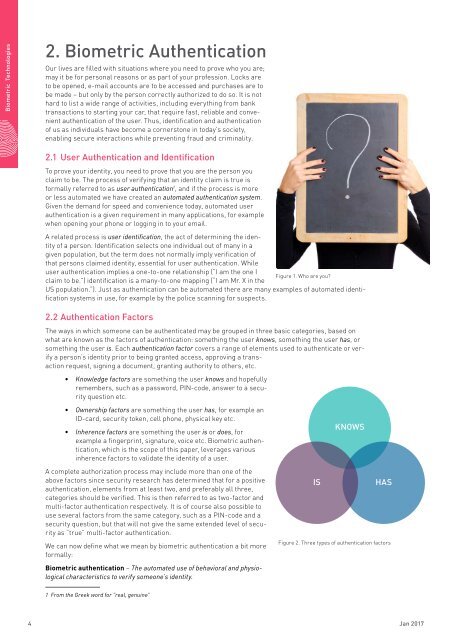BIOMETRIC
Fingerprints-Biometric-Technologies-Whitepaper-January-2017-RevB
Fingerprints-Biometric-Technologies-Whitepaper-January-2017-RevB
You also want an ePaper? Increase the reach of your titles
YUMPU automatically turns print PDFs into web optimized ePapers that Google loves.
Biometric Technologies<br />
2. Biometric Authentication<br />
Our lives are filled with situations where you need to prove who you are;<br />
may it be for personal reasons or as part of your profession. Locks are<br />
to be opened, e-mail accounts are to be accessed and purchases are to<br />
be made – but only by the person correctly authorized to do so. It is not<br />
hard to list a wide range of activities, including everything from bank<br />
transactions to starting your car, that require fast, reliable and convenient<br />
authentication of the user. Thus, identification and authentication<br />
of us as individuals have become a cornerstone in today’s society,<br />
enabling secure interactions while preventing fraud and criminality.<br />
2.1 User Authentication and Identification<br />
To prove your identity, you need to prove that you are the person you<br />
claim to be. The process of verifying that an identity claim is true is<br />
formally referred to as user authentication 1 , and if the process is more<br />
or less automated we have created an automated authentication system.<br />
Given the demand for speed and convenience today, automated user<br />
authentication is a given requirement in many applications, for example<br />
when opening your phone or logging in to your email.<br />
A related process is user identification, the act of determining the identity<br />
of a person. Identification selects one individual out of many in a<br />
given population, but the term does not normally imply verification of<br />
that persons claimed identity, essential for user authentication. While<br />
user authentication implies a one-to-one relationship (“I am the one I<br />
Figure 1. Who are you?<br />
claim to be.”) identification is a many-to-one mapping (“I am Mr. X in the<br />
US population.”). Just as authentication can be automated there are many examples of automated identification<br />
systems in use, for example by the police scanning for suspects.<br />
2.2 Authentication Factors<br />
The ways in which someone can be authenticated may be grouped in three basic categories, based on<br />
what are known as the factors of authentication: something the user knows, something the user has, or<br />
something the user is. Each authentication factor covers a range of elements used to authenticate or verify<br />
a person’s identity prior to being granted access, approving a transaction<br />
request, signing a document, granting authority to others, etc.<br />
••<br />
Knowledge factors are something the user knows and hopefully<br />
remembers, such as a password, PIN-code, answer to a security<br />
question etc.<br />
••<br />
Ownership factors are something the user has, for example an<br />
ID-card, security token, cell phone, physical key etc.<br />
••<br />
Inherence factors are something the user is or does, for<br />
example a fingerprint, signature, voice etc. Biometric authentication,<br />
which is the scope of this paper, leverages various<br />
inherence factors to validate the identity of a user.<br />
A complete authorization process may include more than one of the<br />
above factors since security research has determined that for a positive<br />
authentication, elements from at least two, and preferably all three,<br />
categories should be verified. This is then referred to as two-factor and<br />
multi-factor authentication respectively. It is of course also possible to<br />
use several factors from the same category, such as a PIN-code and a<br />
security question, but that will not give the same extended level of security<br />
as “true” multi-factor authentication.<br />
We can now define what we mean by biometric authentication a bit more<br />
formally:<br />
Biometric authentication – The automated use of behavioral and physiological<br />
characteristics to verify someone’s identity.<br />
IS<br />
KNOWS<br />
HAS<br />
Figure 2. Three types of authentication factors<br />
1 From the Greek word for ”real, genuine”<br />
4 Jan 2017


